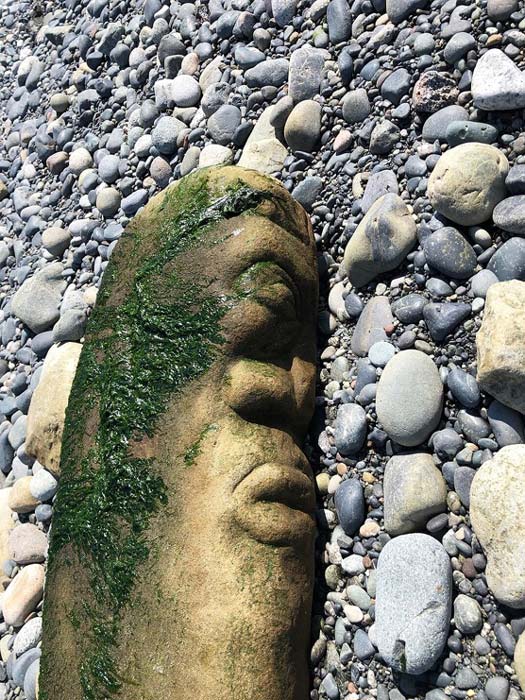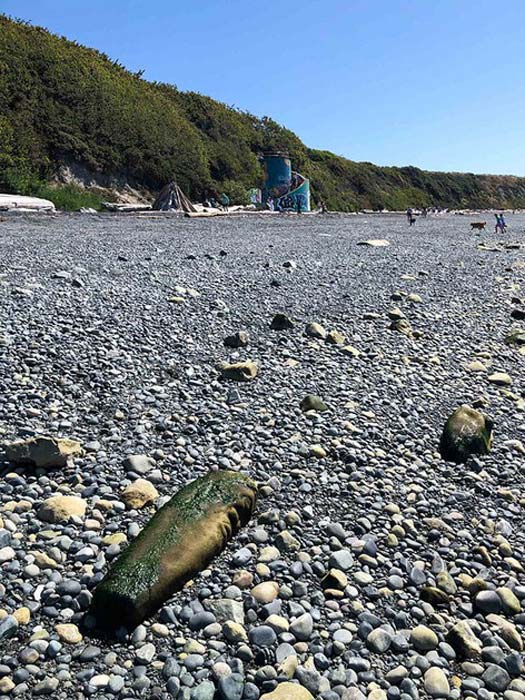An archaeologist from the Royal British Columbia Museum in Canada is being attacked online for “speculating” that a curious carved stone figure found on a western Canadian beach in British Colombia was a Lekwungen people artifact. While the artifact “might” be modern, when you know the facts, perhaps you, like me, will want to jump into this scrap and cover the controversial Mr. Keddie’s back. He deserves the support of all of us history lovers out there.

The stone carving was discovered by Bernhard Spalteholz while walking on a beach in British Colombia, Canada. The Canadian artwork has since sparked controversy due to its possible misidentification by an archaeologist at the Royal British Colombia Museum. (Bernhard Spalteholz / Royal B.C. Museum )
Misinterpretation of the Canadian Artwork
Weighing around 100 kilograms (220 lbs) the stone face discovered on a Canadian beach has bulging eyes and a twisted nose and lips. It was discovered by local man, Bernhard Spalteholz, early one morning last summer on a British Colombia beach. The artifact finder notified an archaeologist at the museum in Victoria . Jack Lohman, head of the Royal British Columbia Museum said in a blog post at the time that he was “astounded” and that the discovery was “a remarkable find with a remarkable story.”
In January last year museum archaeologist, Grant Keddie, announced that the stone figure was “most likely” a ceremonial pillar carved by the Lekwungen people who have long lived in the area. However, a recent article in The Guardian says that a Canadian artist, Ray Boudreau, who lives nearby the beach, told a local paper that “he had carved the figure no more than three years ago.”

Is it a modern-day work of art, or an ancient indigenous carving? (Bernhard Spalteholz / Royal B.C. Museum )
The Mistake in Identifying the Canadian Artwork
Last week sculptor Ray Boudreau told a Times Colonist that “it’s absolutely 110% my carving” and supporting his claim he provided photos of a sculpture he executed in 2017 which the Times Colonist writer called “a strikingly similar sculpture.” Boudreau said he used a simple hammer and chisel to shape the distinctive face before the stone vanished from the beach. What happened next is the controversial bit.
After Boudreau’s comments became public, according The Guardian , “the museum quietly deleted the blogpost and any other references to the discovery.” This “apparently” sly act sparked a fierce debate over the museum’s methods of identifying the initial findings. Now, their entire approach to such discoveries is being brought into question.

Left: Photograph by Bernhard Spalteholz of the beached Canadian artwork. Right: Photo by Victoria artist Ray Boudreau of a rock he carved back in 2017 which he believed had been stolen.
Reaction from the Royal BC Museum
While Keddie at the museum can be criticized for having deleted the original post, you’d have to be inhuman to not understand why he might do so. We’ve all sent an email or text message to the wrong person with dire effects, and we’ve all wished there was a magic button to take it back. Well, Keddie had access to that delete button and couldn’t resist pressing it. Plus, if you know you have posted some incorrect information, of course you no longer want to spread false info. The key protocol that we know in publishing (and a museum worker might not) is to acknowledge that the information has been updated due to error.
It takes a brave, and selfless person, to stand up and speak out in support of someone when they come under public attack. The champion of this story is Lou-ann Neel , head of the Royal BC Museum’s Indigenous Curation and Repatriation Department, who says perhaps “the public has been too quick to pass judgment.” Neel said there are a lot of questions she’d like to ask the artifact finder. For example, it is yet unclear if Mr. Boudreau started working on a stone “that already had a carving on it”. Furthermore, Neel points out that the shape of the carved face is “wide on one end and tapering at the other,” and as an Indigenous artist herself she is perfectly qualified to point out that it is similar to other Indigenous stone figures discovered in the region.
Don’t Shoot the Archaeologist!
Let’s now personify the museum archaeologist, Grant Keddie, who last year “speculated” that the stone pillar discovered in Canada “might” be the same one Indigenous elders talked about in the 1880s, and that it was “probably” used in Lekwungen salmon and puberty ceremonies. Note the words “speculated,” “might” and “probably.”
Skeptical, and many deeply-cynical, locals are marching on social media shunning Keddie for his initial findings. However, the fight just got bigger, because Keddie just found a new ally – good old me (and hopefully us). Why should we rally around Mr. Keddie? Because has over fifty years’ experience as archaeological curator at the Royal B.C. Museum and he himself is a museum of knowledge pertaining to the natural and social history of the Indigenous First Nations cultures in Canada.
Right now a faction of armchair archaeologists is stretching their fingers, getting ready to annihilate me, and perhaps Mr. Keddie again too. But think about this for a second. At the best, maybe Mr. Keddie realized his earlier speculation was inaccurate and didn’t want to mislead the public further, so he simply deleted the post. At worst, he tried to cover his ass and protect his professional integrity. Wouldn’t you do the same?
Top image: The Canadian artwork was discovered on a Dallas Road beach below Beacon Hill Park at low tide. Museum archaeologist Grant Keddie speculated that it “might” be a Lekwungen people artifact. Source: Bernhard Spalteholz / Royal B.C. Museum
By Ashley Cowie
Related posts:
Views: 0
 RSS Feed
RSS Feed

















 February 9th, 2021
February 9th, 2021  Awake Goy
Awake Goy  Posted in
Posted in  Tags:
Tags: 
















